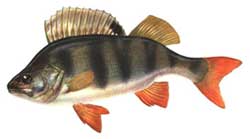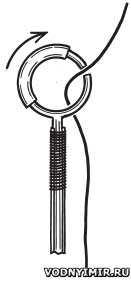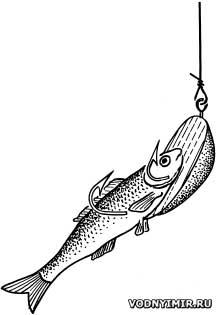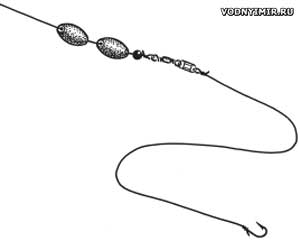Perch fishing from hydraulic structures. The method of vertical spinning. Perch fishing with a running donkey
 Spring is a very promising season for perch fishing of different sizes, and one of the the most catchy places are the water areas near the hydraulic structures.
Spring is a very promising season for perch fishing of different sizes, and one of the the most catchy places are the water areas near the hydraulic structures.
In the spring, during fish spawning, flocks of perch of different sizes often concentrate near bridges or old piles, locks, piers, dams, dams, water collectors and other hydraulic structures, where there is always a fast or even a seething stream of water enriching the adjacent water area with air bubbles, thanks to which algae grow violently. And in algae, fry quickly develop from the deposited caviar, which together with caviar serve as food for the ubiquitous perch. Piers and other coastal structures serve as a shelter for both fry and perch, which arranges its ambushes here.
Piers, hotels on the water and similar structures attract fry with an abundance of food. Where ships are constantly moored, there is always a surf and a rip wave that washes various food from the shore and from the branches of the coastal shrub. In addition, in such places, various food waste can get into the water, which also accustoms small fish to the place. On the Volga, Oka, Don and other rivers, you can always see boys with fishing rods who prefer to catch small fish, in particular perch, from piers and piers. And their catch, I must say, is very decent.
A lot of fry, and, accordingly, perch, also always happens in the area of yacht clubs and in the parking lots of various vessels. In yacht clubs, yachts are launched in large numbers, usually by the end of May or the beginning of June. Before that, they are being prepared — painting, putty, checking the work of gear and motors on the stocks and in the boathouses, so the adjacent water area remains calm. The perch, guarding the fry and pecking caviar from the fouling, remains almost undeterred. He hides under the shadow of numerous piers and piers, feels great there and pecks well on various nozzles.
 Fig. 1. The ring of the tip of the rod with a cut and a moving cambrick. |
In May 2007, our friend was staying with a friend at a dacha located on the shore of the Klyazma reservoir. His friend had a yacht stored nearby at the yacht club, and they went to see it. Just in case, our friend took with him a fly rod — a six-meter rod and a minimal set of rigs. While he was walking with a friend in the forest, he picked up red worms under old leaves. After inspecting the yacht, he walked along the long coastal bridges to the far corner of the yacht club under the overhanging crowns of trees, where at a depth of 1.5 m he began to drag small perches one by one. The striped ones reacted well to the planning nozzle, so he left only the minimum weight on the fishing line and increased the length of the leash to 30 cm. The worm was baited on a small hook, with an accordion, without leaving hanging ends. It can be assumed that the perches in that place were attracted by fry that fed on some larvae or insects falling from trees, and maybe the perches themselves fed on this food.
But even more interesting happened later, when our friend replaced the float rigging with a nod. On his fishing rod, the rigging changed easily: he took off one foam reel with the rigging wound on it from the third from the tip of the knee and put on another. For ease of fixing the fishing line on the tip of the rod, he installed a pass ring of increased diameter made of rigid copper wire, in which he made a cut on the side to pass the fishing line. A cambrick is put on the ring, which moves with effort (Fig. 1). When running fishing, when the depths, casting range and, accordingly, fishing tactics are constantly changing, it is often necessary to use alternately nodding and float rigging. However, you can do with an ordinary ring at the end of the rod, but then you will have to completely unwind the reel and pass the loop of the fishing line (it clings to the horn of the reel) into the end ring of the whip. It takes time. You can fasten the fishing line on the tip of the whip without the help of a ring, wrapping the fishing line with tape. However, this is also not very convenient, since you have to use a knife every time to release the fishing line, cutting the wound tape. Another option for quick-release fastening of the fishing line — by means of a long camber cut along, which is wrapped with a thin copper wire — is shown in Fig. 2.
 Fig. 2. The method of attaching the fishing line to the tip of the rod using a cambrick and copper wire. |
When our friend began using the «ant» jig and a nod to catch places near the piles, suddenly, one after another, large perches began to come across, weighing up to 300 g. It seemed that it was not important for them how the bait played. As soon as the jig was in sight of the humpbacks, the nod almost immediately curved smoothly, and the fight with the strong fish began.
In general, large perches are well taken for mormyshki (of various shapes and colors) and near other kinds of hydraulic structures. So near the upper part of the dam of the Middle Tsaritsyn Pond, many anglers in the spring more than once came across perches weighing about a kilogram. The game was mostly smooth, with a wide amplitude and a slow rise of the bait 15-25 cm from the bottom, and then followed by a rise with increasing acceleration without changing the amplitude and frequency of the game. But it happens that the perch reacts well to a uniform or gradually accelerating wiring during the ascent with a minimum amplitude and increased frequency of play. So you can fish in tandem with small non-landing «devils» of black color without planting, located at a distance of 15-25 cm from each other. «Devils» can be used tungsten or lead — the most important thing is that their total weight straightens the fishing line. It is curious that large Tsaritsyn perches resist very little when vyvazhivanii at any time of the year; this was confirmed by our friend, who successfully catches pond perch in autumn by spinning with the use of small rotating spinners.
 Fig. 3. Flat-oval jig for fishing for fry. |
Sometimes the perch pursues the «devil» from the very bottom, but does not dare to bite or touches the bait quite easily. In this case, you need to play longer with the upper «devil» near the bottom, reduce the distance between the devils and after the second «devil» is detached from the bottom, immediately start accelerated wiring. Then the predator has a feeling that one organism is chasing another organism, and the perch instinctively rushes ahead.
In the spring, many anglers catch perch near dams, but not many explore the adjacent water area with a jig, and with it you can catch perch on the border of a boiling stream and calmer water. It is necessary to pick up a jig of such weight that it, held on a taut fishing line by a nod, slides down gravel and stones along the stream. So with the right choice of location, you can carry out wiring for 3-5 m, and sometimes more.
As a nozzle for this method of fishing, a red worm, a bunch of large moths, a «sandwich» of a moth with a maggot, a dragonfly larva, a klepsin leech, a bokoplava, including a fry on special large flat-oval jigs (Fig. 3) are used.
Vertical spinning method
It is not customary to talk about the baiting of perch in the spring due to the fact that fishing for spinning in the spring is prohibited. However, vertical baiting with small baubles is unlikely to cause damage to the fish population, especially when it comes to dipping. After all, this predator, as already mentioned, actively feeds on caviar and fry of various fish in the spring, including fish of valuable breeds, which is why its fishing is even encouraged in the lower reaches of the Volga.
At this year's All-Russian competitions in winter baubles held at the Ivankovsky reservoir, the organizers, together with the fish inspection, also encouraged the fishing of small perch (after all, it is known that athletes take credit even on five-gram perch). They explained the need for this by the fact that in the spring, small sailors cause huge damage to fish offspring in spawning areas.
 Fig. 4. Three-sided perch with a hanging tee and a red fly. |
In our opinion, perch fishing by vertical baiting in reservoirs is quite justified. At the same time, it is not necessary, and in many cases even impossible, to fish with a spinning rod. It is better to equip the rod with a rigid whip with the same foam reel. If this is a «telescope», then with the help of a light spinner it is possible to successfully catch both areas close to the angler and those remote from him.
Spinning can be carried out on several levels. Often the perch feeds near the bottom, but sometimes takes the nozzle at a distance of 60 cm to 1 m from the bottom, or even in the water column. The game at the bottom should be performed with a uniform amplitude (10-20 cm): rhythmic lifting of the spinner with an interval of 5-8 seconds and lowering it to the same level. But sometimes the perch reacts well only to a quick game. It can be carried out at different levels, and consists in sharp rises of the spinner with the tip of the rod from the starting position by 10-15 cm with a second interval. Often, if there is no bite for a long time, it is this method that allows you to detect in which layer of water perch.
Especially good conditions for perch fishing are created where old boats, barges, motor ships and steamers are moored. Fishing from the landing stages is successful in the spring. So, one day in May, my fishing friends and I rested in the Volga Delta at one of the bases. The landing stage on which the hotel was located stood on a deep channel. There was no need to go somewhere far away — humpback perches weighing up to 500 g were actively pecking at small planning baubles right under the side of the landing stage. The perch took well on a silver-colored spinner, but reacted best to a silver trihedron (the dimensions of the spinner are 12x40 mm, both sides are slightly concave) with a hanging tee. A red fly made of silky threads had to be tied to the tee (Fig. 4).
What is characteristic is this: a strong current was pulling under the landing stage, and most of the large perch stood on the border of a strong and slow current under branches accumulated under the side, reeds, driftwood and other debris. Before sunrise, a flock of large perches went out to frolic on the shoal, which was located between the landing stage and the shore, where the humpbacks immediately threw themselves at a worm brought from Moscow, thrown into the water with a Bologna fishing rod with a strong rig and a short release of the nozzle.
 Fig. 5. A homemade spinner with a double and a foil wrapper. |
Another successful perch fishing was in his youth at one of the authors on the pier «Coniferous Forest», when, while on a hike, he made a fishing rod from a hazel, tied a homemade spinner to it and, waiting for the boat «Rocket» to Moscow, unexpectedly caught five weighty perches in a short time. With the manufacture of a homemade spinner, he then had to be wise. As a spinner, he used a nondescript brass emblem from jeans. The emblem was a short narrow strip and had holes at both ends, through one of which your author attached a small twin with a copper wire, and tied a fishing line to the other end. To make the spinner shine better, he wrapped it with chocolate foil and wrapped it with the same copper wire for reliability (Fig. 5).
The perch stood in the corner between the pier and the landing stage, where the dump was located to the depth, and reacted well to short strokes at the bottom, attacking the bait on the move, so fishing turned out to be very exciting. Maybe your author would have caught more fish then, but soon the «Rocket» came, and it was time to leave...
With the help of spinners designed for vertical baiting, it is also possible to successfully catch perch on the already mentioned horizontal streams near dams and water collectors, using bait in the same way as a jig. The tension of the fishing line is very clearly controlled by contact with the ground; wiring can be carried out stepwise. Great catchability is given by planting a fry on a flat spinner, for which a second hook is soldered onto it. The spinner is taken of an elongated shape, narrow at the top and expanding downwards, a suitable length for the hook is 30 mm, 35 mm, 37 mm, 45 mm, 50 mm, occasionally more. The spinner should roll along with the fry from side to side in an attractive way, therefore, when making a spinner designed for planting fry, you first need to experiment on some fast water flow.
Bass fishing with a running donkey
Bass fishing is also successful in places where ferries dock, where deep-water areas are adjacent to shallow depths. For example, on the Moscow — Volga canal, you can successfully catch perch from ferry piers. Here it is possible to use various gear — flywheel and Bologna fishing rods, plug, fishing rod with a side nod and a jig, a half-dunk and even a winter nod fishing rod equipped with a jig or a hook with a sinker. But one of the most effective ways to catch perch is fishing on a running donkey.
 Fig. 6. Rigging for a running donkey with a light loading of two olive sinkers. |
For a running donkey, a spinning rod with a length of 2.4-2.8 m with a test of 10-40 g is suitable. For casting on a strong current, it is better to take a high-power spinning with a test load of 20-60 g. The coil is selected inertia-free with a spool diameter of 35-45 mm with adjustable wiring speed. But in general, any spinning reel will do. It is better to use a braided fishing line with a diameter of 0.12-0.14 mm, since it sails less on the current. But it needs to be tied with a reliable «griner» type knot at least 1 m of monofilament fishing line with a diameter of 0.35 mm with a locking swivel, a bead and a sliding sinker. A carabiner for a replaceable leash is attached to the swivel. Depending on the strength of the current, you can use leashes from 15 to 50 cm long. For a strong current, a long leash is preferable, on which the nozzle moves better. Loading weight — from 10 to 60 g. Usually one or two olive sinkers installed one after the other or a flat diamond-shaped or oval sinker are used. The hook is usually placed one No. 8-10 with a long forearm (Fig. 6).
Earthworms or red worms are used as bait in the spring. The earthworm is good because it is hard and holds well on the hook when wiring. Since the perch has a large mouth, the bait should be voluminous. Therefore, they take a worm up to 10 cm long and stick it on a hook with a dense accordion. You can break the worm in half and bait the hook with two halves, piercing them in two or three places. When the biting is sluggish, and the casting is short-lived, you can hook a bunch of small dung or podlistnik. Attractively wriggling with their free ends, they will definitely provoke the perch to bite.
Casts are made, as a rule, on the lower part of the dump, and fishing is carried out by the method of stepwise wiring: they tear the rigging from the bottom and, after making two or three turns with the coil, stop the winding. The pauses should last several minutes, since the perch is not always active, but it happens that it grabs the nozzle while moving. If the bottom does not threaten with hooks, then it is possible to carry out the wiring with careful short tugs, which often has an effect with a bad bite. But usually near berths and piers, as well as in ports, the bottom abounds with boulders and other bottom piles, so when fishing on a running donkey, a large supply of leashes on the reel is always required.
Share this page in the social. networks or bookmark:
